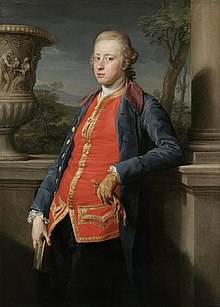
Duke of Devonshire is a title in the Peerage of England held by members of the Cavendish family. This branch of the Cavendish family has been one of the wealthiest British aristocratic families since the 16th century and has been rivalled in political influence perhaps only by the Marquesses of Salisbury and the Earls of Derby.
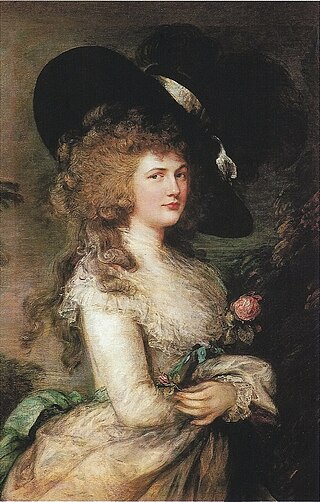
Georgiana Cavendish, Duchess of Devonshire, was an English aristocrat, socialite, political organiser, author, and activist. Born into the Spencer family, married into the Cavendish family, she was the first wife of William Cavendish, 5th Duke of Devonshire, and the mother of the 6th Duke of Devonshire.
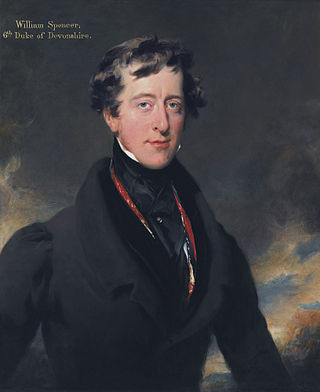
William George Spencer Cavendish, 6th Duke of Devonshire,, styled Marquess of Hartington until 1811, was a British peer, courtier, nobleman and Whig politician. Known as the "Bachelor Duke", he was Lord Chamberlain of the Household between 1827 and 1828 and again between 1830 and 1834. The Cavendish banana is named after him.

William Cavendish, 7th Duke of Devonshire,, styled Lord Cavendish of Keighley between 1831 and 1834 and Earl of Burlington between 1834 and 1858, was a British landowner, benefactor, nobleman, and politician.

George Howard, 6th Earl of Carlisle of Castle Howard,, styled Viscount Morpeth until 1825, was a British statesman. He served as Lord Privy Seal between 1827 and 1828 and in 1834 and was a member of Lord Grey's Whig government as Minister without Portfolio between 1830 and 1834.
William Beauclerk, 8th Duke of St Albans was an English aristocrat.

Granville Leveson-Gower, 1st Earl Granville,, styled Lord Granville Leveson-Gower from 1786 to 1815 and The Viscount Granville from 1815 to 1833, was a British Whig statesman and diplomat from the Leveson-Gower family.
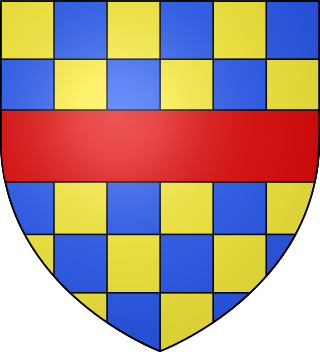
Baron Clifford is a title in the Peerage of England created by writ of summons on 17 February 1628 for Henry Clifford, the heir of Francis Clifford, 4th Earl of Cumberland. Francis was believed to hold the Barony de Clifford, created in 1299, which could therefore be used to give Henry a seat in the House of Lords during his father's lifetime via a writ of acceleration. However, it would later be determined that the barony had in fact passed to his niece, Lady Anne Clifford. The summons of 1628 therefore unintentionally created a new barony, held by Henry. In 1641, on his father's death, Henry inherited the earldom of Cumberland, which became extinct upon his own death in 1643.

Frances Villiers, Countess of Jersey was a British courtier and Lady of the Bedchamber, one of the more notorious of the many mistresses of King George IV when he was Prince of Wales, "a scintillating society woman, a heady mix of charm, beauty, and sarcasm".

Elizabeth Christiana Cavendish, Duchess of Devonshire was an English aristocrat and letter writer. She is best known as Lady Elizabeth Foster, the close friend of Georgiana Cavendish, Duchess of Devonshire. Elizabeth supplanted the Duchess, gaining the affections of William Cavendish, 5th Duke of Devonshire and later marrying him. Several of her letters are preserved.
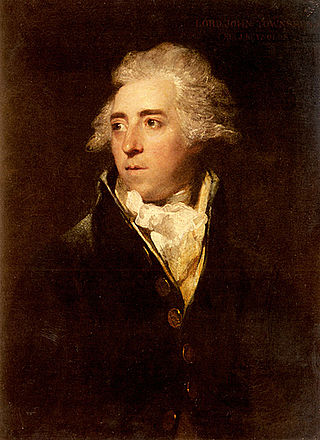
Lord John Townshend PC, styled The Honourable John Townshend until 1787, was a British Whig politician.
Admiral Edward Granville George Howard, 1st Baron Lanerton, was a British naval commander and politician.

Henrietta Ponsonby, Countess of Bessborough, born Lady Henrietta Frances Spencer, was the wife of Frederick Ponsonby, 3rd Earl of Bessborough; the couple were the parents of Lady Caroline Lamb. Her father, John Spencer, 1st Earl Spencer, was a great-grandson of John Churchill, 1st Duke of Marlborough. Her sister was Georgiana Cavendish, Duchess of Devonshire.
The Hon. George Ponsonby, was an Irish politician, who served as a Junior Lord of the Treasury in the governments under Earl Grey and Lord Melbourne from 1832 to 1834.
William George Howard, 8th Earl of Carlisle was an English clergyman and peer.

Harriet Leveson-Gower, Countess Granville was a British society hostess and writer. The younger daughter of Lady Georgiana Spencer and the 5th Duke of Devonshire, she was a member of the wealthy Cavendish and Spencer families and spent her childhood under the care of a governess with her two siblings.
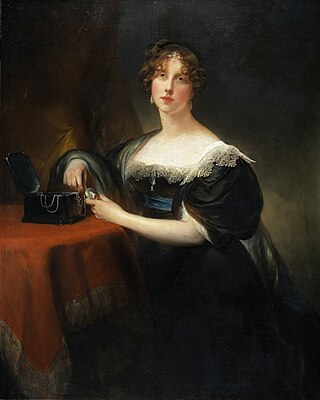
Georgiana Dorothy Howard, Countess of Carlisle was a British noblewoman. She was born after nine years of childless marriage between William Cavendish, 5th Duke of Devonshire, and his wife, Lady Georgiana Spencer, the political hostess and socialite. As such, she was a member of one of the country's grandest and richest families.

Mary Elizabeth Grey, Countess Grey was a British aristocrat and political hostess. She is notable for being the wife of the prime minister in the 1830s through her marriage to Charles Grey, 2nd Earl Grey.

Blanche Cavendish, Countess of Burlington, was the wife of William Cavendish, 2nd Earl of Burlington, who would later become the 7th Duke of Devonshire.
Catherine Cavendish, Duchess of Devonshire, formerly Catherine Hoskins, was the wife of William Cavendish, 3rd Duke of Devonshire, and mother of the 4th Duke.
